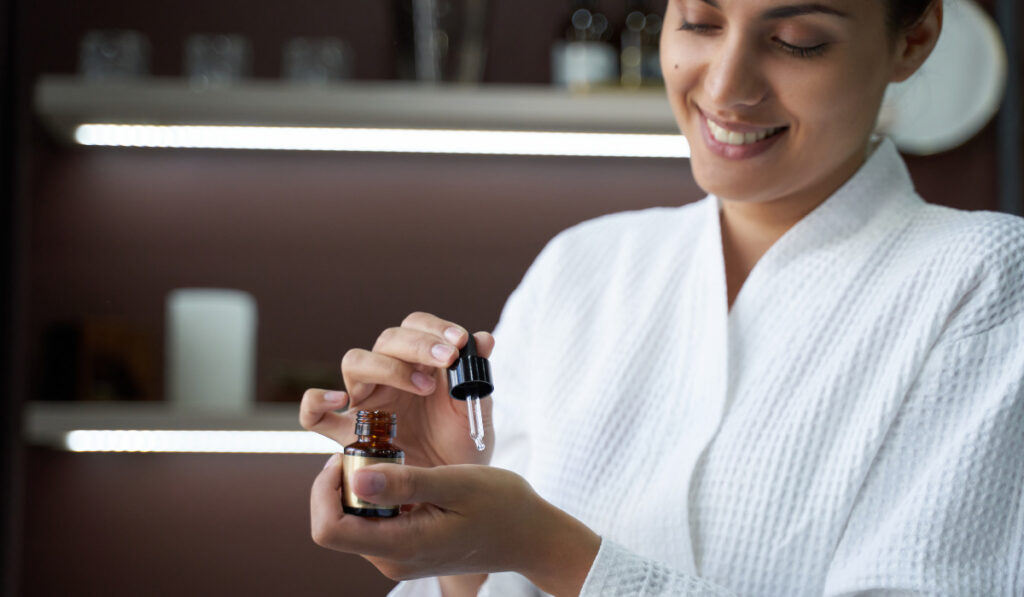Lately, more and more people are using natural skincare products, and among them, different oils have become really popular. It’s time to say goodbye to regular moisturizers because face oils are now a must-have in your beauty stuff. They’re great at keeping your skin moist and happy, no matter what kind of skin you have. And don’t worry, they won’t make your skin feel oily or cause pimples. Even better, they have good stuff like polyphenols, fatty things, and antioxidants that work together to make your skin less red, fight inflammation, and make it look fresh and shiny. Whether you want to calm down redness, deal with acne or other skin issues, make your skin look fuller, or just keep it hydrated, keep reading to find out which natural oils are best for your skin. In this big guide, we’ll talk about the best oils for your skin, what makes them special, and how to use them to get the glowing skin you want.
Different skin types and their needs
Before you pick a skin oil, it’s important to know what kind of skin you have and what it needs. Skin types are usually one of these:
- Dry Skin: This skin is low on moisture, feels tight or flaky, and might look dull with fine lines.
- Oily Skin: This skin makes too much oil, so it looks shiny, has big pores, and can get acne and blackheads.
- Combination Skin: This skin is like a mix of dry and oily parts. Usually, the forehead, nose, and chin are oily, and the cheeks might be dry.
- Sensitive Skin: This skin gets irritated easily, gets red, and can have allergies. It can be dry, oily, or a bit of both.
- Normal Skin: This skin is balanced, not too oily or dry, and usually doesn’t have big problems.
Picking the right oil for your skin type can really help you get healthy-looking skin.
Choosing the best oil for your skin
Now that we have established the science behind facial oils, let’s explore some of the best options for various skin types and concerns:
- Jojoba Oil
Jojoba oil is often called a “skin twin” due to its remarkable similarity to the skin’s natural sebum. This makes it an excellent choice for all skin types, including oily and sensitive. Jojoba oil helps balance oil production, making it ideal for those struggling with excess sebum. It also possesses anti-inflammatory properties and can soothe irritated skin. Jojoba oil is a versatile option and can be used on its own or mixed with other oils or skincare products. .
- Argan Oil
Derived from the kernels of the argan tree, argan oil is rich in vitamin E, essential fatty acids, and antioxidants. It is particularly beneficial for dry and mature skin types, as it deeply hydrates and nourishes. Argan oil helps improve skin elasticity and can reduce the appearance of fine lines and wrinkles. Additionally, its non-comedogenic nature ensures it won’t clog pores.
- Rosehip Oil
Rosehip oil is renowned for its ability to fade scars, reduce hyperpigmentation, and improve skin texture. It is packed with vitamins A and C, both of which promote collagen production and skin regeneration. This oil is a fantastic choice for those with acne-prone skin or seeking anti-aging benefits.
- Coconut Oil
Coconut oil has garnered significant attention for its moisturizing properties and versatility. However, it’s important to note that while coconut oil works wonders for some, it can be comedogenic for others, potentially causing breakouts. It’s best suited for individuals with dry or dehydrated skin. Look for cold-pressed, unrefined coconut oil for the most benefits.
- Tea Tree Oil
Tea tree oil is a powerhouse for acne-prone skin. Its natural antibacterial and antimicrobial properties make it effective in combating acne-causing bacteria. It can be used as a spot treatment or diluted with a carrier oil for larger areas of concern. It’s important to use tea tree oil sparingly, as it can be quite potent.
- Shea Butter
While not an oil in the traditional sense, shea butter deserves a mention for its exceptional moisturizing and nourishing properties. Extracted from the nuts of the shea tree, shea butter is rich in phenols and plant sterols, providing anti-inflammatory and antioxidant benefits. It’s an excellent choice for dry skin and can be used on the face and body.
- Olive Oil
Rich in vitamins A, D, E, and K, olive oil is a potent moisturizer and particularly beneficial for dry skin. Look for extra virgin olive oil that is unrefined and cold-pressed for the highest quality and benefits.
Key benefits of using essential oils for better skin
- Natural Hydration: Essential oils such as jojoba, rosehip, and argan oil are rich in fatty acids, which help moisturize the skin naturally, leaving it soft and supple.
- “Reduced Acne: Tea tree oil and lavender oil have antimicrobial properties that can combat acne-causing bacteria and reduce breakouts.
- Anti-Aging: Essential oils like frankincense and rosemary are packed with antioxidants that can help reduce the appearance of fine lines and wrinkles, promoting a more youthful complexion.
- Even Skin Tone: Some essential oils, like carrot seed oil and geranium oil, can help fade dark spots and promote a more even skin tone.
- Soothing Irritation: Chamomile and calendula oils have anti-inflammatory properties, making them excellent choices for calming irritated or sensitive skin.
- Natural Glow: Many essential oils, such as rosehip and argan oil, contain vitamins and nutrients that can give your skin a radiant glow.
- Tightened Pores: Cypress and lemongrass oils have astringent properties that can help tighten enlarged pores, reducing their appearance.
- Scar Healing: Essential oils like lavender and helichrysum can aid in the healing of scars and promote the regeneration of healthy skin tissue.
- Protection from UV Damage: Certain oils, such as carrot seed oil, offer natural sun protection and can help shield the skin from UV damage.
- Stress Relief: Essential oils like lavender, chamomile, and rose can have a calming effect, reducing stress and promoting overall skin health.
Remember to perform a patch test before using any essential oil to ensure you don’t have an adverse reaction, and always use them in diluted form, as they are highly concentrated.
Factors to Consider When Choosing Skin Oils
When you’re picking a skin oil, it’s not just about knowing your skin type. Here are some other things to think about:
- Clogging Rating: Some oils can clog your pores more than others. If you get pimples, go for oils that are less likely to do that.
- Sensitivity: Check if you have any allergies or things that make your skin unhappy. Always try a little of the new oil on your skin first to make sure it doesn’t make you break out.
- How It Feels: Some oils feel light and soak in fast, while others feel heavy on your skin.
- What You Want: Think about what you want the oil to do. Do you want it to make your skin less dry, fight wrinkles, or help with acne? Different oils do different things.
- Quality: Look for oils that are pure and don’t have extra stuff added in. Organic and cold-pressed oils are usually good choices.
Incorporating facial oils into your skin Routine
To get the most from facial oils, you need to use them right in your skincare routine. Here’s how:
Step 1: Cleaning
Start by cleaning your face to get rid of makeup, dirt, and bad stuff. This makes the facial oil work better on your skin.
Step 2: Toning (If You Want)
If you use a toner, put it on after cleaning but before the facial oil. Toners help balance your skin and make other stuff soak in better.
Step 3: Putting on the Facial Oil
Put a few drops of the oil you picked in your hand. Rub your hands together to warm the oil, then gently press it onto your face, neck, and upper chest. Move your hands up and out to spread it evenly.
Step 4: Moisturizing
If your skin is very dry, you can use your regular moisturizer after the oil to keep your skin feeling good. But lots of people find that the oil alone makes their skin happy enough.
Step 5: Sunscreen
In the morning, finish your skincare routine with a sunscreen that protects against UV damage to keep your skin safe.
Potential Hazard and Allergic Sensitivity Caused by Natural Oils
Potential Hazard
People like natural oils because they’re less likely to make your skin angry compared to the man-made stuff often used in makeup and skin products. But, you should know that natural oils can still cause problems.
Your face’s skin is usually more sensitive than the skin on your arms and legs. So, putting oils on your face might sometimes make it red or annoyed, unlike when you use them on your arms and legs. Also, using oils on your skin before going out in the sun can make you more likely to get a sunburn.
Allergic Reactions
You could have an allergic reaction. If you see your skin getting red or annoyed after using natural oil, it’s smart to stop right away. If things get worse, like if your skin swells up, you get hives (itchy bumps), or have trouble breathing, it could be a very serious allergic reaction. You need to use epinephrine (a special medicine) and call 911 because there’s a risk of dying.
Conclusion
People have used natural oils for a long time to make their skin healthy and look good. No matter if your skin is dry, oily, a mix of both, sensitive, or normal, there’s an oil that can help you a lot. If you know what kind of skin you have, what it needs, and what different oils can do, you can pick the right one for you.
Remember, taking care of your skin is a personal journey. What helps one person might not help another. So, pay attention to what your skin tells you, be patient, and change things if you need to. If you use the right oil and stick to a good skincare routine, you can get the healthy, shiny skin you want. Now, which oil is best for your skin? The answer is about knowing your skin and picking the oil that fits it best.
FAQS
Certainly! Adding frequently asked questions (FAQs) can provide valuable information for readers seeking more specific guidance on using oils for skincare. Here are three FAQs to include in the article:
- Can I use oil-based skincare products if I have oily skin?
Yes, you can use oil-based skincare products even if you have oily skin. In fact, using the right oils can be beneficial for oily skin. Many natural oils, such as jojoba oil, grapeseed oil, and argan oil, have properties that can help balance oil production and hydrate the skin without clogging pores. Look for non-comedogenic oils, and consider incorporating them into your skincare routine in moderation. Some oil-based products, like oil cleansers, can also help remove excess sebum and impurities without over-drying your skin.
- How do I perform an oil cleanse, and is it suitable for all skin types?
Oil cleansing is a cleansing method that involves using an oil-based cleanser to remove makeup, sunscreen, and impurities from your skin. Here’s how to perform an oil cleanse:
- Start with dry hands and a dry face.
- Apply the oil cleanser to your face, gently massaging it in circular motions for about 1-2 minutes.
- Rinse your face with warm water, and gently wipe away the oil and impurities with a soft cloth or cotton pad.
- Follow up with a water-based cleanser to remove any remaining residue.
Oil cleansing suits most skin types, including dry, oily, and combination skin. However, the choice of oil may vary based on your skin’s needs. Dry skin types may benefit from richer oils like almond or avocado oil, while those with oily skin may prefer lighter options like jojoba or grapeseed oil.
- Can I mix different oils together for a more customized skincare routine?
Yes, you can mix different oils together to create a customized skincare routine tailored to your specific skin needs. This is often referred to as “oil blending.” To do this:
- Choose oils that target your skin concerns. For example, if you want hydration and anti-aging benefits, you might mix argan oil with rosehip seed oil.
- Use a clean, dark glass bottle to mix your oils. Dark glass helps protect the oils from light and air, which can cause them to degrade.
- Experiment with different oil combinations, but start with small quantities to ensure you don’t have a negative reaction.
- Patch-test the blend on a small area of your skin to make sure it doesn’t cause irritation or breakouts.
Remember that everyone’s skin is unique, so what works well for one person may not be suitable for another. Customized oil blends can be a great way to address your specific skin concerns and preferences.







